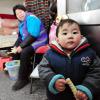
Options Magazine, Winter 2023: The potential rise in fertility following the end of China's one-child policy might create a dual challenge for workers in the short term, according to a recent study.
Women’s participation in the labor force in China has been high compared to the rest of the world, but that rate is falling, creating a new gender gap in the Chinese workforce.
IIASA Population and Just Societies Program researcher, Guillaume Marois and his student, Shuomei Liu, used logistic regression models to explore the impact of having children on the labor force among married women in China.
Their results show that having children, especially more than one, significantly reduces married women’s labor force participation in China. Similarly, they found that having a younger child has a much more significant negative impact on workforce participation.
Additionally, the researchers discovered that the negative effect of having children on women’s labor force participation is stronger for highly educated women. Results also suggest that public childcare services and supportive family policies are needed to mitigate these childbearing effects and promote gender equality.
“A potential increase in fertility resulting from the end of the one-child policy could create a double burden for workers in the short term as higher fertility decreases women’s workforce participation,” explains Marois. “This shrinks the pool of potential workers who will have to pay for both a higher number of children and a growing number of elderly people, thus exacerbating population aging challenges. This underlines the importance of reducing the barriers that prevent mothers from reconciling their family and professional life.”
By Jeremy Summers
Publications
Liu, S. & Marois, G. (2023). The effect of motherhood on the labour force participation of married women in China. Asian Population Studies 20 (1) 104-120. 10.1080/17441730.2023.2193518.
